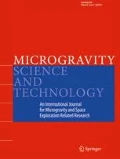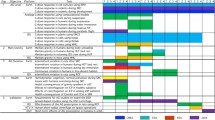Abstract
Research on Artificial Gravity (AG) created by linear acceleration or centrifugation has a long history and could significantly contribute to realize long-term human spaceflight in the future. Employing centrifuges plays a prominent role in human physiology and gravitational biology. This article gives a short review about the background of Artificial Gravity with respect to hypergravity (including partial gravity) and provides information about actual ESA ground-based facilities for research on a variety of biosystems such as cells, plants, animals or, particularly, humans.










Similar content being viewed by others
References
Anken, R.: On the role of the central nervous system in regulating the mineralization of inner-ear otoliths of fish. Protoplasma 229, 205–208 (2006)
Anken, R., Hilbig, R.: Determination of the threshold of gravity for the susceptibility to kinetosis in fish - a centrifuge experiment in the ZARM drop-tower employing gradually reduced gravity. 36th Committee on Space Research (COSPAR) Science Assembly (2006)
Bacabac, R., Smit, T., Loon, J.v., Zandieh Doulabi, B., Helder, M., Klein-Nulend, J.: Bone cell responses to high-frequency vibration stress: Does the nucleus oscillate within the cytoplasm?. FASEB J 20, 858–864 (2006)
Ballarino, J., Howland, H.: Centrifugation of 2G does not affect otoconial mineralization in chick embryos. Am. J. Physiol. 246, 305–310 (1984)
Barrat, M., Pool, S. (eds.): Principles of Clinical Medicine for Space Flight. Springer, New York (2008)
Beysens, D., Carotenuto, L., Loon, J.v., Zell, M. (eds.): Laboratory Science with Space Data: Accessing and Using Space-Experiment Data. Springer Science & Business Media (2011)
Brinckmann, E.: ESA hardware for plant research on the international space station. Adv. Space Res. 36, 1162–1166 (2005)
Brown, A., Chapman, D., Johnsson, A., Heathcote, D.: Gravitropic responses of the Avena coleoptile in space and on clinostats. I. Gravitropic Response Threshold. Physiol. Plant. 95, 27–33 (1995)
Clément, G., Buckley, A.: Artificial Gravity. Springer, New York (2007)
Clément, G., Paloski, W., Charles, J.B., Norsk, P., Maneesh, A., Smith, L., Cromwell, R., Kugler, J., Gilbert, C., Baumann, D.: International Workshop on Research and Operational Considerations for Artificial Gravity Countermeasures, in NASA Center for AeroSpace Information. 2014. http://ston.jsc.nasa.gov/collections/TRS/_techrep/TM-2014-217394.pdf (2014)
Diaz, A., Trigg, C., Young, L.: Combining ergometer exercise and artificial gravity in a compact-radius centrifuge. Acta Astronaut. 113, 80–88 (2015)
ESA: ESA-GBF Continuously open research announcement access to ground based facilities for life-, physical-, and interdisciplinary- sciences. ESA Multimedia. http://esamultimedia.esa.int/docs/hsf_research/cora/CORA_GBF.pdf(2010)
Frett, T., Mayrhofer, M., Schwandtner, A.R., Petrat, G.: An innovative short arm centrifuge for future studies on the effects of artificial gravity on the human body. Microgravity Sci. Technol. 26, 249–255 (2014)
Friedrich, U., Joop, O., Pütz, C., Willich, G.: The slow rotating centrifuge microscope NIZEMI — A versatile instrument for terrestrial hypergravity and space microgravity research in biology and materials science. J. Biotechnol. 47, 225–238 (1996)
Glade, N., Beaugnon, E., Tabony, J.: Ground-based methods reproduce space-flight experiments and show that weak vibrations trigger microtubule self-organisation. Biophys. Chem. 121, 1–6 (2006)
Hall, T.: Artificial gravity and the the architecture of orbital habitats. J. Brit. Interplanet. Soc. 52, 290–300 (1999)
Häder, D.P., Hemmersbach, R., Lebert, M.: Gravity and the Behaviour of Unicellular Organisms. Cambridge University Press, Cambridge (2005)
Hemmersbach, R., Voormanns, R., Bromeis, B., Schmidt, N., Rabien, H., Ivanova, K.: Comparative studies of the graviresponses of Paramecium and Loxodes. Adv. Space Res. 21(21), 1285–1289 (1998)
Herranz, R., Anken, R., Boonstra, J., Braun, M., Christianen, P., Martin de, G., Hauslage, J., Hilbig, R., Hill, R., Lebert, M., Medina, J., Vagt, N., Ullrich, O., Van Loon, J., Hemmersbach, R.: Ground-based facilities for simulation of microgravity, including terminology and organismic specific recommendations for their use. Astrobiology 13, 1–17 (2013)
Holderman, M., Henderson, E.: Nautilus-X Multi.Mission Space Exploration Vehicle. NASA Johnson Space Center. Scribd Online Service. http://de.scribd.com/doc/51592987/Nautilus-X-Holderman-1-26-11 (2011)
Jamon, M.: The development of vestibular system and related functions in mammals: impact of gravity. Front. Integr. Neurosci. 8, 1–13 (2014)
Joosten, B.: Preliminary assessment of artificial gravity impacts to deep-space vehicle design. NASA Johnson Space Center, JSC-63743 (2007)
Kiss, J.: Plant biology in reduced gravity on the Moon and Mars. Plant Biol. 16, 12–17 (2014)
Konstantinova, I., Antropova, Y., Legenkov, V., Zazhirey, V.: Study of reactivity of blood lymphoid cells in crew members of the Soyuz-6, Soyuz-7 and Soyuz-8 spaceships before and after flight (blatogenesis delay of lymphocytes). Space Biol. Med. 7, 48–55 (1973)
Lang, T., LeBlanc, A., Evans, H., Lu, Y., Genant, H., Yu, A.: Cortical and trabecular bone mineral loss from the spine and hip in long-duration spaceflight. J. Bone Miner. Res. 19, 1006–1012 (2004)
Lansdorp, B., Kruijff, M., Heide, E.: The need for MARS-g in LEO: manned antecedent for reduced and simulated gravity. In: Proceedings 54th International Astronautical Congress of the International Astronautical Federation (IAF), the International Academy of Astronautics and the International Institute of Space Law 1, pp 2111–2118 (2003)
Laurinavičius, R., Stočkus, A., Buchen, B., Sievers, A.: Structure of cress root statocytes in microgravity (Bion-10 mission). Adv. Space Res. 17, 91–94 (1996)
Lim, D., Stith, J., Stockwell, C., Oyama, J.: Observations on sacculus of rats exposed to longterm hypergravity. Aerosp. Med. 45, 705–710 (1974)
Limbach, C., Hauslage, J., Schäfer, C., Braun, M.: How to activate a plant gravireceptor. Early mechanisms of gravity sensing studied in characean rhizoids during parabolic flights. Plant Physiol. 139, 1030–1040 (2005)
Loon, J.v.: Hypergravity studies in the Netherlands. J. Gravitat. Physiol. 8, 139–142 (2001)
Loon, J.v.: BioPack: The ground controlled late access biological research facility. J. Gravitat. Physiol. 11, 57–63 (2004)
Loon, J.v., Bergh, L.v.d., Schelling, R., Veldhuijzen, J., Huijser, R.: Development of a centrifuge for acceleration research in cell and developmental biology. 44th International Astronautical Congress, IAF/IAA-93-G (1993)
Loon, J.v., Javier Medina, F., Stenuit, H., Istasse, E., Heppener, M., Marco, R.: The National – ESA Soyuz missions Andromède, Marco Polo, Odissea, Cervantes, DELTA and Eneide. Microgravity Sci. Technol. 19, 9–32 (2007)
Loon, J.v., Veldhuijzen, J., Kiss, J., Wood, C., Ende, H.v.d., Guntemann, A., Wubbels, R.: Microgravity Research starts on the ground. Apparatuses for long-term ground based hypo-and hypergravity studies. In: Proceedings 2nd European Symposium Utilisation of the International Space Station, pp 415–420. ESTEC, Noordwijk, The Netherlands (1999)
Martin, D., South, D., Wood, M., Bungo, W., Meck, J.: Comparison of echocardiographic changes after short- and long-duration spaceflight. Aviat. Space Environ. Med. 73, 532–536 (2002)
Mehta, S., Laudenslager, M., Stowe, R., Crucian, B., Sams, C., Pierson, D.: Multiple latent viruses reactivate in astronauts during Space Shuttle missions. Brain Behav. Immun. 41, 210–217 (2014)
Mehta, S., Stowe, R., Feiveson, A., Tyring, S., Pierson, D.: Reactivation and shedding of cytomegalovirus in astronauts during spaceflight. J. Infect. Dis. 182, 1761–1764 (2000)
Moore, S., Clément, G., Dai, M., Raphan, T., Solomon, D., Cohen, B.: Ocular and perceptual responses to linear acceleration in microgravity: alterations in otolith function on the COSMOS and Neurolab flights. J. Vest. Res. 13, 377–394 (2003a)
Moore, S., Cohen, B., Clément, G., Curthoys, I., Dai, M., Koizuka, I., Kubo, T., Raphan, T.: Ocular counter-rolling during centrifugation and static tilt. In: Buckey, J., Homick, J. (eds.) The Neurolab Spacelab Mission: Neuroscience research in Space. NASA SP-2003-535, pp 11–17 (2003b)
Morita, M.: Directional gravity sensing in gravitropism. Annu. Rev. Plant Biol. 61, 705–720 (2010)
Neubert, J., Schatz, A., Briegleb, W., Bromeis, B., Linke-Hommes, A., Rahmann, H., Slenzka, K., Horn, E.: Early development in aquatic vertebrates in near weightlessness during the D-2 mission STATEX project. Adv. Space Res. 17, 275–279 (1996)
Nicogossian, N., Huntoon, C., Pool, S., Johnson, P.: Space Physiology and Medicine. Lea & Febiger, Philadelphia (1988)
Otto, C., Ploutz-Snyder, R.: Astronaut preflight cardiovascular variables associated with vascular compliance are highly correlated with post-flight eye outcome measures in the visual impairment intracranial ressure (VIIP) syndrome following long duration spaceflight. Human Research Program Investigators’ Workshop, TX, United States (2015). JSC-CN-32236
Pedrozo, H., Wiederhold, M.: Effects of hypergravity on statocyst development in embryonic Aplysia californica. Hear. Res. 79, 137–146 (1994)
Pletser, V., Winter, J., Duclos, F., Bret-Dibat, T., Friedrich, U., Clervoy, J.-F., Gharib, T., Gai, F., Minster, O., Sundblad, P.: The first joint European partial-G parabolic flight campaign at Moon and Mars gravity levels for science and exploration. Microgravity Sci. Technol. 24, 383–395 (2012)
Schuber, M., Seibt, D., Anken, R.: BIOLAB on the international space station (ISS): facility and experiments. Curr. Biotechnol. 2, 201–207 (2013)
Wagner, E., Granzella, N., Saito, H., Newman, D., Young, L., Bouxsein, M.: Partial weight suspension: a novel murine model for investigating adaptation to reduced musculoskeletal loading. J. appl. Physiol. 109, 350–357 (2010)
Wagner, E.: The Mars Gravity Biosatellite Program is closing down. http://www.spaceref.com/news/viewsr.html?pid=31612,postedWednesday (2009)
Wang, G.-H., Li, G.-B., Hu, C.-X., Liu, Y.-D., Song, L.-R., Tong, G.-H., Liu, X.-M., Cheng, E.T.: Performance of a simple closed aquatic ecosystem (CAES) in space. Adv. Space Res. 34, 1455–1460 (2004)
Wehland, M., Ma, X., Braun, M., Hauslage, J., Hemmersbach, R., Bauer, J., Grosse, J., Infanger, M., Grimm, D.: The impact of altered gravity and vibration on endothelial cells during a parabolic flight. Cell. Physiol. Biochem. 31, 432–451 (2013)
Wolverton, S., Kiss, J.: An update on plant space biology. Gravitat. Space Biol. 22, 13–20 (2009)
Zander, V., Anken, R., Pesquet, T., Brungs, S., Latsch, J.: Short radius centrifuges – a new approach for life science experiments under hyper- gconditions for applications in space and beyond. Recent Patents Space Technol. 3, 74–81 (2013)
Zeredo, J., Toda, K., Matsuura, M., Kumei, Y.: Behavioral responses to partial-gravity conditions in rats. Neurosci. Lett. 529, 108–111 (2012)
Author information
Authors and Affiliations
Corresponding author
Ethics declarations
Conflict of interests
We, the authors declare that we have no conflict of interest.
Rights and permissions
About this article
Cite this article
Frett, T., Petrat, G., W. A. van Loon, J.J. et al. Hypergravity Facilities in the ESA Ground-Based Facility Program – Current Research Activities and Future Tasks. Microgravity Sci. Technol. 28, 205–214 (2016). https://doi.org/10.1007/s12217-015-9462-9
Received:
Accepted:
Published:
Issue Date:
DOI: https://doi.org/10.1007/s12217-015-9462-9




